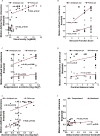Motion-Defined Form Perception in Deprivation Amblyopia
- PMID: 38573617
- PMCID: PMC10996940
- DOI: 10.1167/iovs.65.4.13
Motion-Defined Form Perception in Deprivation Amblyopia
Abstract
Purpose: The purpose of this study was to assess motion-defined form perception, including the association with clinical and sensory factors that may drive performance, in each eye of children with deprivation amblyopia due to unilateral cataract.
Methods: Coherence thresholds for orientation discrimination of motion-defined form were measured using a staircase procedure in 30 children with deprivation amblyopia and 59 age-matched controls. Visual acuity, stereoacuity, fusion, and interocular suppression were also measured. Fixation stability and fellow-eye global motion thresholds were measured in a subset of children.
Results: Motion-defined form coherence thresholds were elevated in 90% of children with deprivation amblyopia when viewing with the amblyopic eye and in 40% when viewing with the fellow eye. The deficit was similar in children with a cataract that had been visually significant at birth (congenital) and in children for whom the cataract appeared later in infancy or childhood (developmental). Poorer motion-defined form perception in amblyopic eyes was associated with poorer visual acuity, poorer binocular function, greater interocular suppression, and the presence of nystagmus. Fellow-eye deficits were not associated with any of these factors, but a temporo-nasal asymmetry for global motion perception in favor of nasalward motion suggested a general disruption in motion perception.
Conclusions: Deficits in motion-defined form perception are common in children with deprivation amblyopia and may reflect a problem in motion processing that relies on binocular mechanisms.
Conflict of interest statement
Disclosure:
Figures



References
-
- Asper L, Crewther D, Crewther SG.. Strabismic amblyopia. Part 1. Psychophysics. Clin Exp Optom . 2000; 83;49–58. - PubMed
-
- Kugathasan L, Partanen M, Chu V, et al. .. Reading ability of children treated for amblyopia. Vision Res . 2019; 156: 28–38. - PubMed
-
- Wong A. New concepts concerning the neural mechanisms of amblyopia and their clinical implications. Can J Ophthalmol . 2012; 47: 399–409. - PubMed
MeSH terms
Grants and funding
LinkOut - more resources
Full Text Sources
Medical

